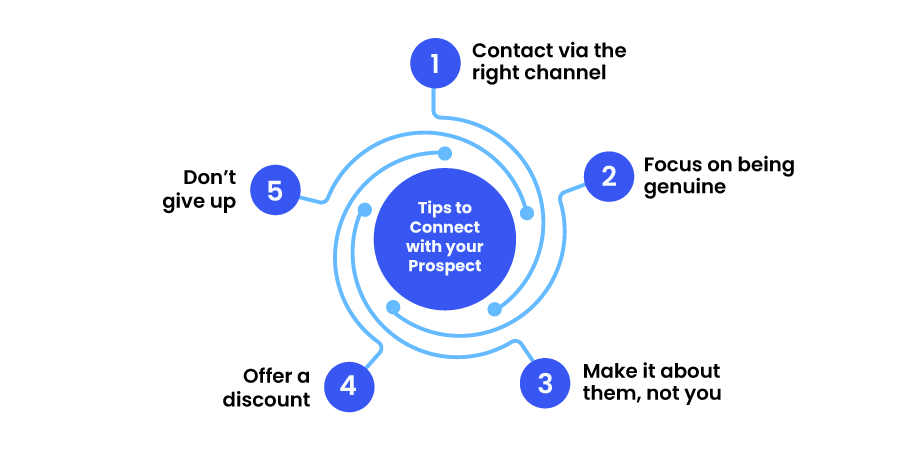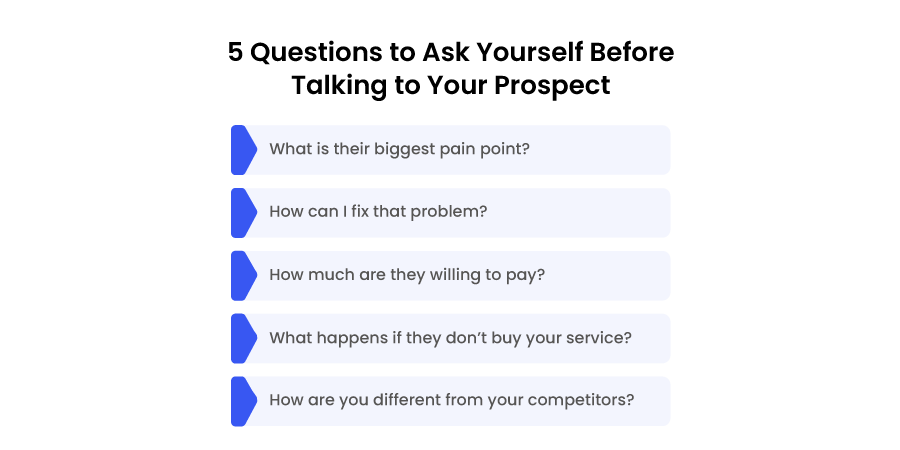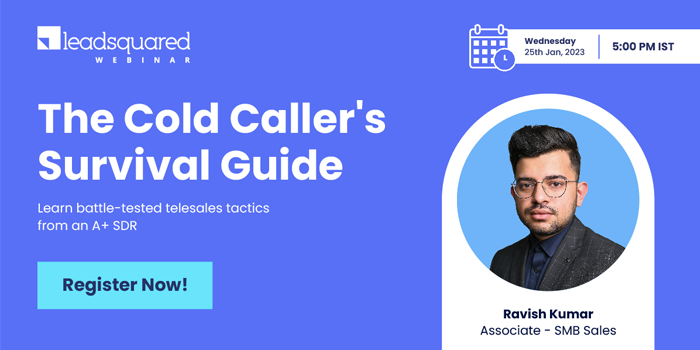In this webinar, Ravish Kumar, LeadSquared’s A+ sales rep, shares a few stories about his wins and losses, along with some great advice for his fellow cold callers. Watch the webinar to learn about the strategies he adopted and the tech solutions that have helped him make over 10,000 cold calls.
This article will provide a few cold calling tips to keep in mind when conducting a successful conversation with a client. We have simplified the process into three actionable steps for you!
- The first step is to identify the correct point of contact (POC) and ensure that the solution being offered has relevance to their business.
- Then, you need to pitch a solution that is tailored to the person you’re approaching, whether through LinkedIn, email, cold call, or WhatsApp conversation.
- The final step is to understand and solve the hurdles that’ll arise while reaching out to high-level POCs, such as CEOs and COOs, and how to maintain a professional hierarchy.
Additionally, we will talk about overcoming the fear barrier and structure the entire conversation from introduction to conclusion, focusing on making a lasting first impression.
Let’s start with a telesales strategy that helps your sales team achieve their cold calling targets.
Creating the Perfect Telesales Strategy for 2023
Cold calling is a sales strategy that involves making unsolicited phone calls to potential customers with the aim of generating new business. It is a popular method used by many sales professionals to reach out to a large number of people and promote their products or services. Cold calling can be challenging and time-consuming, but it can also be highly effective if done correctly. Here, we will explore various cold calling statistics to give you a better understanding of its success rate, the impact, and how to optimize your cold calling approach for maximum results.
Let’s take a look at some cold calling statistics from the webinar:
- On average, if 100 calls are made, they lead up to 2 demos. This means to get a qualified prospect on call, you must dial close to 50 calls.
- On top of that, 50% of connected calls don’t serve the intended purpose — a massive loss of manpower and agent time.
- We need to be very clear about the prospects they reach out. The model that they intend to serve their business/entity should find a proper fitment.
- The qualification of a prospect is the most important filter which a salesperson needs to identify.
At a basic level, if one makes 100 calls, two or more meetings can be obtained. But it is important to understand that some people might not even pick up your call.
So, in the few instances when they do pick up your call, it needs to be a success! You can do so by adding value and building a friendly relationship with the client. Once that’s done, to ensure the highest success rate, the follow-up cycle should be well-defined. Don’t bombard your customers with calls and emails as too many follow-ups can result in the prospect losing interest.
Show your value to the client and become a friend so they can reach out to you for any help they need. Be clear and properly understand their business and the solutions you can provide them. Prepare KRA’s (Key Result Area) for the meeting, it should be presented and defined according to the company’s pain points so that you can provide them with the best solutions.
How is the Correct Prospect Identified?
Finding the correct prospects is crucial for the success of any cold-calling efforts, whether it’s in sales or marketing. There are numerous tools available that can help you identify and reach out to potential customers. These tools range from basic contact databases to more advanced software incorporating artificial intelligence and machine learning. Whether you are looking to build a targeted list of leads or track the performance of your campaigns, there is a tool out there that can meet your needs.

Here’s a concise overview of the tools that the top SDRs use while cold calling:
- LinkedIn remains the most professional tool when you reach any prospect out. A small tip to remember when reaching out to contacts is to keep messages short and to the point.
- Sales Navigator can be used for emails/contact numbers.
- Website research is very important before approaching any prospect.
- Tools like Adapt, Apollo, and Lusha can also be used for the same.
For example, if someone is interested in your product or solution, the best way to acquire the lead is to first connect on LinkedIn and then follow up with a sales navigator to search for the contact’s email address or phone number.
Also, in order to prospect a company, it is important to determine if the solution is a good fit for them. The next step is to review the LinkedIn profile of the Point of Contact (POC) to see if they have any experience with your product.
For further assistance, the Apollo.io extension can be downloaded from the Chrome browser, which will provide the email contact of the POC. Additionally, Lusha can also be used. Once all of the information is acquired, the reach out mechanism can be decided and the POC needs to be contacted to set up a meeting.
Make the First Level Connect with the Correct Prospect
At this stage, the background research has been completed, and you have a fair idea of the solution that the business needs and whether your product is a good fit. You should also understand the industry that the POC belongs to and where they have worked in the past. Taking these four points into account will help you develop the best approach for the client.
When approaching a company via a cold call, some people prefer a rigorous approach while others prefer to use a hierarchical approach. For example, you can either go directly to a CEO level or follow the hierarchical approach by reaching out to the marketing head first. The intention of the first cold call is to initiate a conversation, understand their pain points, and build trust. In a hierarchical approach, once trust is built, the POC can help the salesperson take the conversation ahead with the CEO for negotiations, pitching, and closure.

Next comes the most important part of the sales process, the pitch. It’s something that every salesperson fears at the start but with the right approach and a few tips up your sleeve, it’s easy to ace this stage.
How to Create the Right Sales Pitch?
Creating the right sales pitch requires a deep understanding of the audience, their needs and what they are looking for. The pitch should be tailored to the specific scenario, whether it’s a cold call, website inquiry, LinkedIn outreach, or customer referral. By doing proper research, tailoring the pitch to the audience’s needs, and keeping it concise and to the point, the sales pitch will be more effective and increase the chances of a successful outcome.
Here are some of the strategies you can use depending on the sales pitch:
Cold Call
Before making a cold call, the first step should be to research the point of contact (POC) on LinkedIn to find out which company they work for, such as BFSI, real estate, or education. This research is important as the purpose of a cold call is to win the client in the first minute. Trust can be built in the conversation by discussing the company’s website, landing page, and products. If successful, the call could last 15-45 minutes.
It is important for employees to do proper homework when they have the details and have taken down the requirements. Employees should make a list of open points and make sure they have ticked them off before leaving their seat.
Ravish Sharma, Associate- SMB Sales, LeadSquared
[Also read: 25 Cold Calling Scripts, Tips, and Best Practices for some ready to use cold-calling scripts.]
Website Inquiry
While calling a prospect who made an inquiry on your website, it is important to have an idea of their requirements before getting on a call with them. This includes mapping the stated conditions and studying their background. The pitch should be tailored to the stated requirements in order to demonstrate that the caller has done their homework.
This helps to create a positive impression and demonstrates that the sales rep knows the product well.
LinkedIn Prospect
The first message outreach on LinkedIn should be short and simple. It is recommended to try and connect with them first, while having a background on the companies they have worked for. It can be beneficial to investigate whether the person has ever used your product or looked into it before.
Additionally, one can use their reference cycle to get in contact with other people which may be beneficial.
Customer Referral
When a customer refers someone to a business, the referred person may have a high expectation of the business due to the referral. To ensure the customer referral pitch is successful, it should be kept short and concise and should be two to three minutes long if the requirements are known, or five to six minutes long if they are not.
Through practice and time, your pitch will definitely become smoother. And Ravish shared a great technique to keep the shivers and the fear at bay, read ahead to know how he does it.
Barriers to Cross While Approaching a POC
The fear of approaching someone at a high level is a natural part of human nature. To reduce this fear, a tool called the ‘Call Reluctance Minimizer‘ has been created to help salespeople in such situations.
Making successful cold calls requires four steps: pattern interruption, pinpointing the trigger, derailment, and replacement. To ensure successful results, it is important to practice these four steps regularly.
Pattern Interruption: Identify the pattern and figure out how the cold call can be initiated without having fear or second thoughts.
Pinpoint the Trigger: Be positive and try to not think about the rejection which you may face later. Don’t hold on to the belief that an intern can’t have a discussion with the CEO of any form. Once the barrier is broken cold calls become directly proportional to the growth of the individual.
Derail + Replace: Replace your fears with a character which makes you confident with going ahead with the call.
Practice + Reward: Once you start following the points that we mentioned above, the rewards will follow down your way for sure.
One should start building confidence by utilizing their free time to increase their skillset. You can do this by reading sales-related articles or by being active on LinkedIn, which is a great source of knowledge.
Ravish Sharma, Associate- SMB Sales, LeadSquared
These techniques will help salespeople move from reluctance to confidence in terms of cold calling. This transition is important if you wish to succeed in sales.

Before beginning a call, it is important to remove fear, be confident, and have a warm greeting ready. If a client asks a question the caller is unfamiliar with, they should reply that they will get back with an answer.
Lead with a positive and have a segmented approach and ensure follow-up calls are never missed. Lastly, it is important to practice and reward yourself on successful calls. With consistent practice, within a few months, the caller will genuinely become an expert and even teach others how to make cold calls.
By overcoming the barriers and successfully engaging the POC, you can then focus on structuring the conversation to effectively showcase your solutions and address the prospect’s needs.
Structure the Whole Conversation with the Prospect
It is possible to gain an understanding of what the prospect is looking for and how to structure one’s conversation. This comes with practice and experience.
To build trust with the prospect, you need to keep the conversation focused on their requirements, rather than the details of the product being offered. It is also important to understand their pain points in order to be prepared with answers while following up.
Gentle follow-ups can be made on calls. For example, if a POC expresses interest in a product and suggests that a call should be made again in the future, it is important to not call them again too soon as this could annoy them.
It is also recommended that a profile of the company, detailing what your product offers, needs to be sent to the POC either via email, WhatsApp or LinkedIn. However, it is important to keep the message short and relevant to their requirements. Lastly, salespeople should take a consultative approach, being a helper and providing assistance to the POC as opposed to just selling the product.

It is important to keep the conversation light, and maybe even crack a few jokes when presenting a product that the company has built. The sales cycle may be unpredictable, with highs and lows. Stay consistent with your practice, as it is likely to pay off in the end. If you stick to your approach, there will come a time when meetings will flow in.
By utilizing technology such as LeadSquared, you can streamline your cold-calling process and minimize inefficiencies, allowing you to focus on what you do best — closing deals. LeadSquared’s powerful automation tools can help you prioritize leads, track call metrics, and even predict the best time to call a lead.
So, are you ready to take your cold-calling game to the next level? Try LeadSquared today and see how our powerful cold-calling automation tools can help you increase your productivity.
FAQs
It depends from market to market. For example, in India, the best time to call a client is between 11:00 and 11:30 AM, as companies may start earlier. It is important to give people the time and space to settle down at their desks before making the call. The same time frame should be used for different regions, as it ensures that the person’s calendar isn’t blocked for other engagements at the start of their day.
To build trust with clients, it is important to maintain a gentle follow up with them. Additionally, sharing information about your company’s certifications, awards, and compliance parameters can provide assurance that your company is reliable and legitimate. For longer deals, creating a WhatsApp group to stay in touch with customers can also help in building trust.
When dealing with customers enquiring about prices, it is important to let them know that there is a range of prices available and that there is room to negotiate. Reassure them that you will work towards finding a model that best suits their needs and budget. Explain that the prices on the website are not necessarily fixed and that there will be a discussion about the best plan for them.

Ravish Kumar
Associate – SMB Sales, LeadSquared







